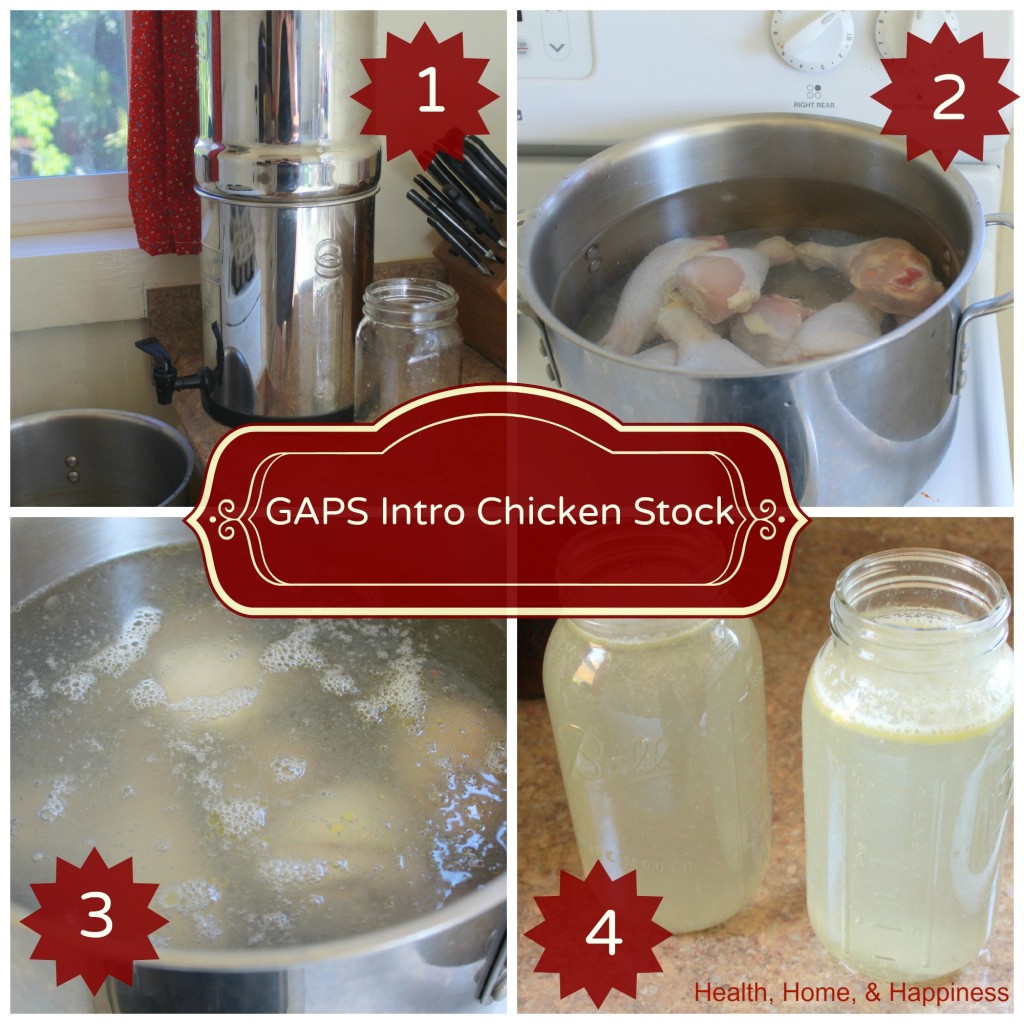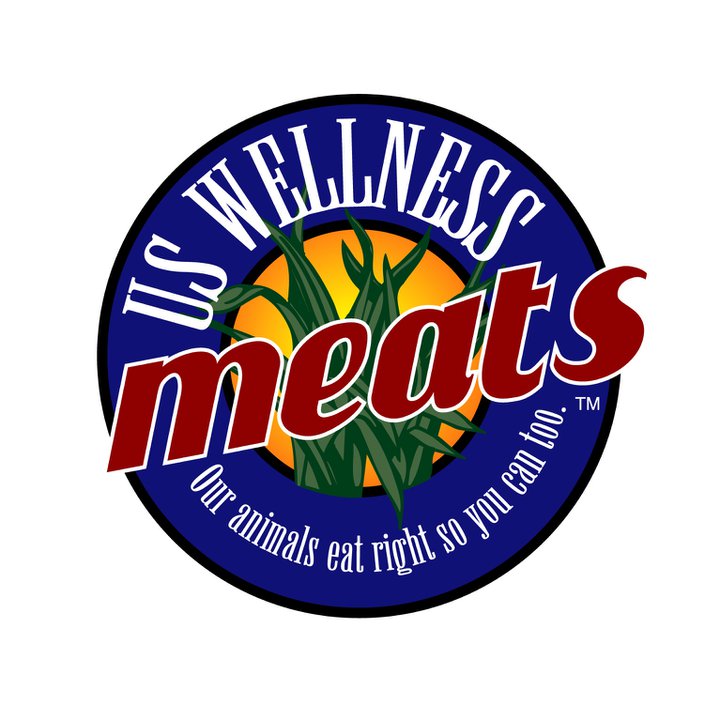
GAPS Intro Chicken stock
This is taken from What Can I Eat Now? 30 Days on the GAPS Introduction Diet Handbook. GAPS Intro chicken stock is different than stock later on, as you don’t brown the bones at all so the stock is pale. This is to prevent any harder to digest well cooked pieces of chicken from slipping through into the stock. You can still salt it to taste with sea salt, and broth is recommended to be served with every meal while on Intro.
Equipment:
click here for berkey water filters

GAPS Introduction Diet Chicken Broth
Ingredients
- Whole chicken or chicken pieces with the meat on still
- Optional: 2 tablespoons fresh thyme, 6 cloves garlic, 1 onion, 1 inch of ginger root, vegetable scraps such as the ends of onions and carrots, core of the cabbage, leaves from celery, etc The rich golden color comes from onion skins and can make broth appear more appetizing, give it a mellow flavor, and add some minerals.
- Filtered Water
Instructions
-
Rinse chicken. Reach inside cavity and remove giblet package. Remove giblets from package and add to the stock pot. Place chicken in the stockpot.
-
Fill pot 3/4 full with filtered water and any optional herbs and vegetables. Cook on medium-high until bubbling, then reduce heat to low and allow to simmer, covered, 4-8 hours. When done, allow to cool then pour broth through a strainer and transfer to mason jars to store in the fridge.
-
To strain, I use a mesh strainer over a pitcher-style 4-cup measuring cup. This makes transferring the broth to the mason jars easier;
-
I do one jar at a time, cleaning out the strainer as needed during the process.
-
Do not discard the soft gelatinous parts around the bones or the skin; reserve that and use an immersion or regular blender to blend it into your broth and soups.
-
The fat will rise to the top of the jars in the fridge, which can be included in soups or used as a fat for cooking.
-
Pick any meat off the bones that you can after the chicken broth has been removed, reserve meat to add to soups or serve alongside. Discard the remaining bones in the pot.
-
Later on the GAPS Diet you can do a ‘second run’ of bone broth with the bones after picking the meat off, but for Intro we want the more gentle meat broth that is made with meat on the bones.
Recipe Notes
The terms 'broth' and 'stock' are often used interchangeably, and can be confusing when trying to figure out the correct form to use for gut healing. In the GAPS Introduction Diet, the important part is that we use bones that still have the meat and bones on them, and that we don't simmer for an long amount of time.
I call this 'broth' as in 'meat broth' but some people call this 'meat stock'. When we simmer our broth for a shorter amount of time, less histamines are produced. Many GAPS people have trouble with histamines, though this intolerance is usually healed when the gut is balanced again.
Since we keep the skin and meat on the bones (rather than eating it off, and then making stock out of the leftover bones) our broth is more rich in protein and fats than it would be otherwise.
Pressure Cookers (Instant Pots) on the GAPS Diet
Pressure cookers are not allowed per the GAPS book. Many of us have experimented with pressure cookers and found no change in how we feel when using them, and so we choose to use them. Instant Pots can make meat broth in the same way that slow cookers do, but in much less time.
Broth made in the Instant Pot has benefits as well, it is less likely to bother those with histamine sensitivities due to the shorter cooking time. It also is fast to make, and the Instant Pot is well contained, so it contains the smell of simmering broth well.
To make meat broth in the Instant Pot, pressure cook on high pressure for 2 hours using the same directions as for stovetop or slow cooker other than the cooking time.
Extra cooked chicken from making broth? Click here to see how to use it.







Hey, just to let you know, you can get “double duty” out of your bones. Instead of discarding after the first boil, put the bones back i the pot with two tablespoons of apple cider vinegar, and if you can get the chickens feet and re-boil and re-simmer. Twice the stock and twice the nutrients as the vinegar draws all the good stuff from the bones:)
Hi Darannie
Thank you so much for sharing!🤗
Hi, I am wondering if you can make the broth in the crock pot instead of a stock pot. Cooking it on low for 8-12 hours? Are the benefits the same?
The benefits would be identical. Once it comes to a boil in the crock pot, simmer for the recommended time. As stated, the histamines are increased if you allow it to cook for a very long period like people will do when making bone broth.
Hi Cara, I just bought your GAPS Intro Guide as we are going to start intro in a few weeks. I’m so glad I got your book because it is really helping me organize all that’s needed to prepare. As stock is such a big part of intro I have a few questions: If using chicken parts how many pounds should I strive for if using a 6 quart pot? Also, would I be messing up intro guidelines if I included a carrot, celery and onion while cooking the broth – but straining it out later? How do you store your broth in the freezer, in glass or plastic? I have had several glass jars crack in the freezer – after I left 2 inches of space and let it cool in fridge first. Thanks for all your help!
Carrots and onion are fine cooked in broth in Stage 1 and up. Celery not until stage 3. I am also trying to figure out how many pounds of parts I need.
Does anyone else have trouble with chicken broth? When I drink it I feel bloated and not great. Wondering if that is a detox of sorts or if my body can’t tolerate it. Any ideas of where I can get more information on that? Considering starting the GAPS this summer for my son and I.
thanks
I do because a lot of the ingredients used in typical bone broth are high FODMAP (hard to digest) like onions, garlic and celery. Try without those/see if you can figure out what’s causing the bloat, and then cut it out until your gut is more healed and try it again to see if you can tolerate :-)
When I took all the soft pieces off my chicken, and the skin, and poured in the stock and it all throughmy Vitamix, it got all yucky and kinda gray! My stock then looked emulsified! What did I do wrong?
Cooking your stock at too high of heat for too long. You really want the meat and bones to simmer instead of a heavy boil for long periods. A cloudy stock isn’t necessarily bad, just not desirable.
I blended in the skin fat and it turned the stock white too. Hoping it will separate out in the fridge, but will use it for soups etc… so not so noticeable.
Cara, in the GAPS Dr. Campbell-McBride instructs to cook the chicken for 1 1/2-2 hours. Can you explain your reasoning for cooking yours much longer? Thanks so much!
Cara please correct the error about the biggest fundamental of GAPS – meat stock vs. broth. It’s harmful everywhere you misinform – on multiple blog pages, YouTube, and in your book, etc.
Because I found your website before starting GAPS the misinformation you provide actually made me really sick until I started working with a CGP (Certified Gaps Practitioner). She said unfortunately it’s all too common that the most important foundation of GAPS and particularly GAPS Intro (the meat stock) is misunderstood and confused, which unfortunately then becomes the most googled search result leading to great harm in some cases.
You use the terms “stock” and “broth” interchangeably, but they are very different and have profoundly different effects on the body.
Please educate yourself and read more about the difference here – http://www.gapsinfo.com/wp-content/uploads/2012/03/Stock-vs.-Broth.pdf
Consuming long-cooked broth at the start of GAPS, particularly for very ill people, can cause huge die-off symptoms that are not only very unpleasant, but in some cases so severe people have been hospitalized. I personally know of one person who after finding a website like yours, consumed long-cooked broth at the start of GAPS Intro and ended up on a 5-day psych hold, due to what the high concentration of glutamic acid on broth did to her brain.
You need to properly explain the differences between stock and broth, their very different effects on the gut and brain, and the different recipes for each. You should not be claiming to know about GAPS when you don’t seem to understand this basic and fundamental difference, and your content is harmful.
I’m making the effort to write to you like this to appeal to you personally, because again –– your misinformation made me extremely sick.
I’m not sure what you’re talking about- I cover this in the article you commented on. During Intro it needs to be cooked a short amount of time. “The terms ‘broth’ and ‘stock’ are often used interchangeably, and can be confusing when trying to figure out the correct form to use for gut healing. In the GAPS Introduction Diet, the important part is that we use bones that still have the meat and bones on them, and that we don’t simmer for a long amount of time.”
Cara, as Adam noted, your recipe above for a GAPS Introduction Diet broth reads “simmer, covered, 4-8 hours”. This is incorrect and needs to be edited, please.
I am grateful for your work, and have followed you for years. But I must underscore what Adam noted, as my child ckearly has a histamine sensitivity and I worry for others who may be trying to help themselves but following incorrect instructions.
Again, I appreciate your work very much which is probably why I write this comment in the hopes to correct this error in this critical recipe, of such an important voice in this community.
Hi.Am starting out on intro.
Have decided to stick to beef and salt only at this as have been carnivore for some time and this is what seems to suit me.
Am using mostly brisket meat and some without the bone.
Is this going to work?